Crossfire: The Plot That Killed Kennedy (64 page)
Read Crossfire: The Plot That Killed Kennedy Online
Authors: Jim Marrs

,Accompanied by CIA agent Lucien Conien, South Vietnam generals
seized key installations and attacked the presidential palace. After hours of
fighting Diem and his brother, Ngo Dinh Nhu, surrendered. While being
taken to the generals' headquarters, both were murdered.
Kennedy, who had approved the coup, then rejected it, then okayed it
again, was genuinely shocked at the murders.
Washington was forced to recognize the new military government in
Saigon, but for the next twenty months, there were no less than ten
changes of government as one general overthrew another.
It was time for a decision in Vietnam-to support a major American
military expedition as desired by the Pentagon or to simply withdraw and
take the criticism of the anticommunists.
The assassination of the Diem brothers may have strengthened Kennedy's decision to disengage from Vietnam, and there is evidence that he
would have curtailed the Vietnam War.
Kennedy, forever the astute politician, also apparently was very much
aware of the approaching 1964 elections.
Senator Mike Mansfield told newsmen that once, following a White
House leadership meeting, Kennedy had confided to him that he agreed
"on a need for a complete withdrawal from Vietnam," but he couldn't do
it until after being reelected.
Kennedy explained to O'Donnell:
"In 1965 I'll be damned everywhere as a Communist appeaser. But I
don't care. If I tried to pull out completely now, we would have another
Joe McCarthy Red Scare on our hands."
The President also may have given a hint as to his plans in a broadcast
on September 2, 1963. Speaking of Vietnam, he said: "In the final
analysis, it is their war. They have to win or lose it."
The people within the Pentagon and the CIA-who had so much to gain
by widening the Vietnam War-continued to put out their conflicting and
often erroneous information.
Shortly before the Diem coup, McNamara and Gen. Maxwell Taylor
had returned from Saigon and told Kennedy that things were looking better
in Vietnam and that the United States would be able to withdraw all
military personnel by the end of 1965.
Less than one month after Kennedy's assassination, McNamara and
Taylor reported to President Johnson that conditions in Vietnam were
grave and that a major effort-including American combat troops and a
massive clandestine program-was needed to prevent a Communist victory.
On hearing the optimistic assessment from McNamara and Taylor on
November 20, 1963, Kennedy had also approved an Accelerated Withdrawal Program, designed to carry out the promise to end American
military presence by the close of 1965.
The withdrawal plan ended two days after Kennedy's assassination when
President Johnson signed National Security Action Memorandum (NSAM)
No. 273 which cancelled the troop withdrawal. This document also subtly
changed the United States objective from simply assisting the South
Vietnamese to assisting them "to win" against the Communists, and authorized
plans for expanding the war into North Vietnam. The memorandum also
ordered senior government officials not to contest or criticize the changes.
Kennedy aide Kenneth O'Donnell, in "Johnny We Hardly Knew Ye,"
wrote, "The President's orders to reduce American military personnel in
Vietnam by one thousand before the end of 1963 was still in effect on the
day he went to Texas. A few days after his death, during the mourning,
the order was quietly rescinded."
Obviously, at this late date, no one wants to claim responsibility for a
ten-year undeclared war that killed fifty-eight thousand Americans, caused
domestic riots and demonstrations, engendered lasting hatreds between
classes and age groups and, according to many, nearly wrecked the
American economy.
Was Kennedy's embryonic move to disengage in Vietnam a catalyst for
his assassination? Was it the straw that broke the back of the militaryindustrial camel?

As terrible as it is to contemplate the involvement of the U.S. military in
the Kennedy assassination, there are many connections between the two.
Several other factors have raised suspicions concerning the military's
role in the assassination.
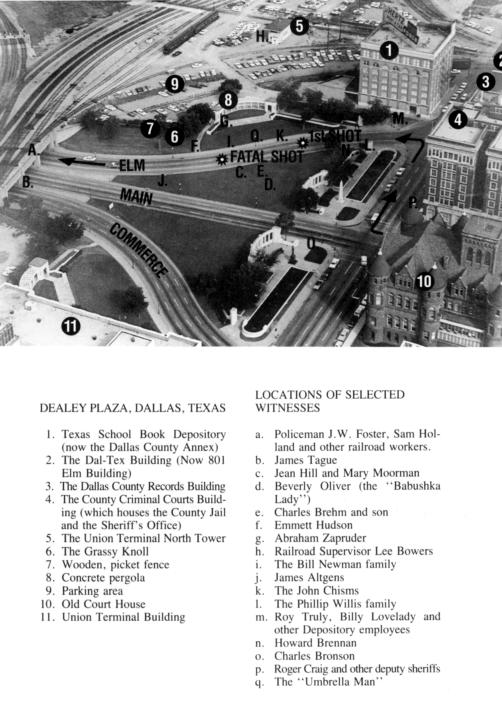
A smiling, robust-looking President John F. Kennedy is shown beginning his
fateful motorcade through Dallas on November 22, 1963. He was accompanied by
his wife, Jackie; Texas Governor John Connally; his wife, Nellie; and Secret
Service Agents Roy Kellerman and William Greer. Kennedy made the trip to
Texas despite warnings of danger and recent ugly right-wing demonstrations in
Dallas.
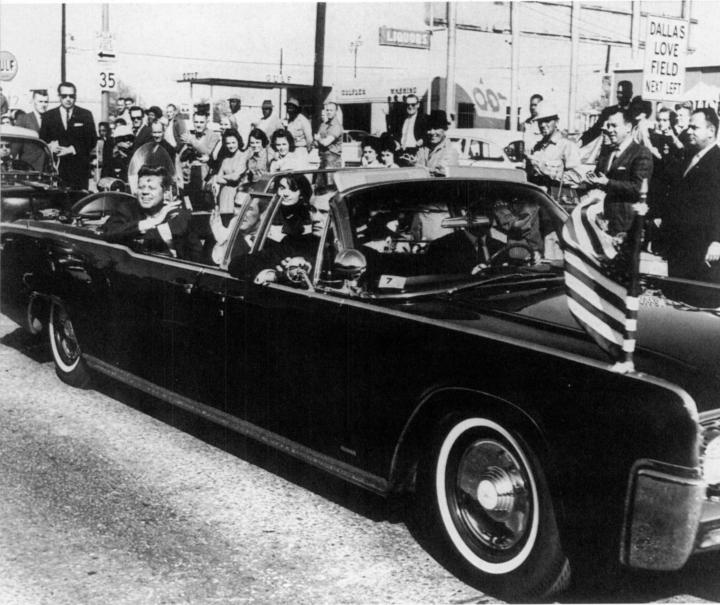
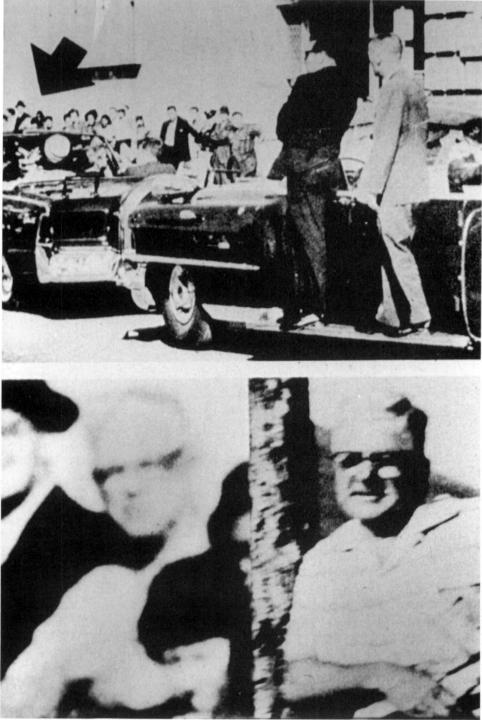
As President Kennedy's limousine approaches the Texas School Book Depository (top), an arrow points to a man in the crowd. Researchers believe
this man (blowup on left) may be Joseph Milteer (right), a Miami right-wing
extremist who was tape recorded by a police informant telling of Kennedy's
impending assassination in Dallas two weeks prior to the event. This same
informant received a call from Milteer on the day of the assassination.
Milteer said he was calling from Dallas. This is one of several documented
incidents of persons with foreknowledge of the assassination.
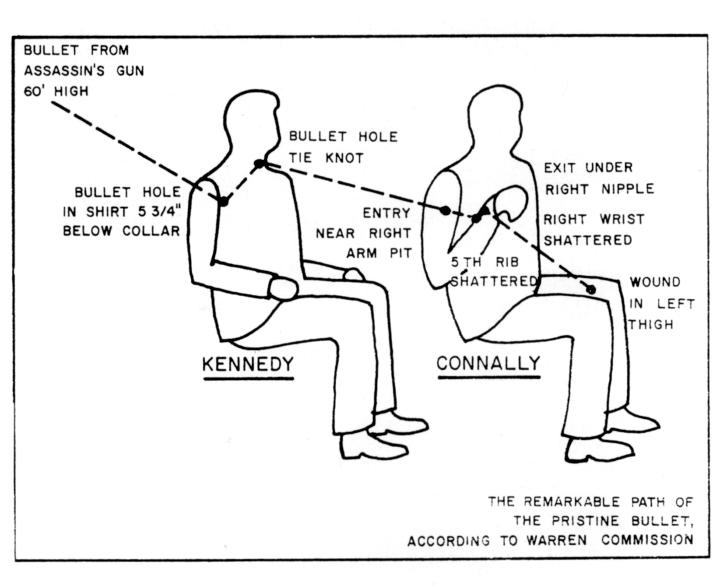
The Government's lone-assassin theory rests on the idea of a single
bullet acting in the manner described in this diagram and remaining
virtually intact afterward.
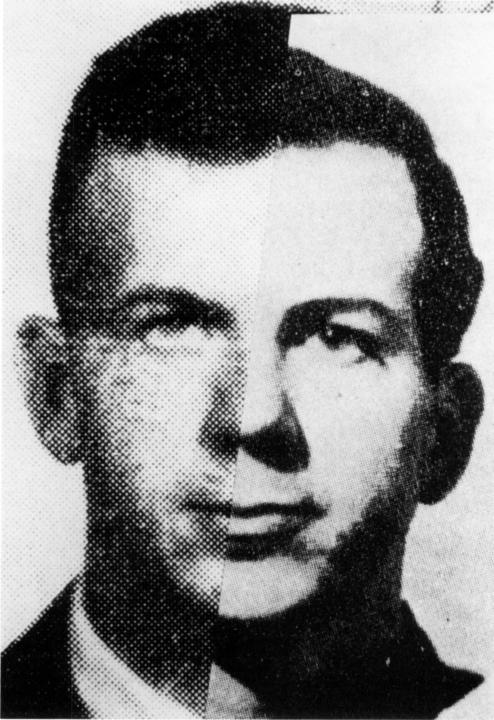
JACK WHITE Photoanalysis
Above, Texas researcher Jack White has combined the left-hand side of a
photograph of Marine Lee Harvey Oswald with the right-hand side of a
photo reportedly made in Russia. He discovered that when all the facial
features are brought into alignment, the Russian Oswald's left ear and
head are significantly shorter than the Marine Oswald. Marine Corps
records report Oswald as 6' I" and the Oswald autopsy report stated he was
5'9". It is discrepancies such as these which have caused many researchers
to believe that the Oswald killed in Dallas may not have been the same
Oswald born in New Orleans in 1939.
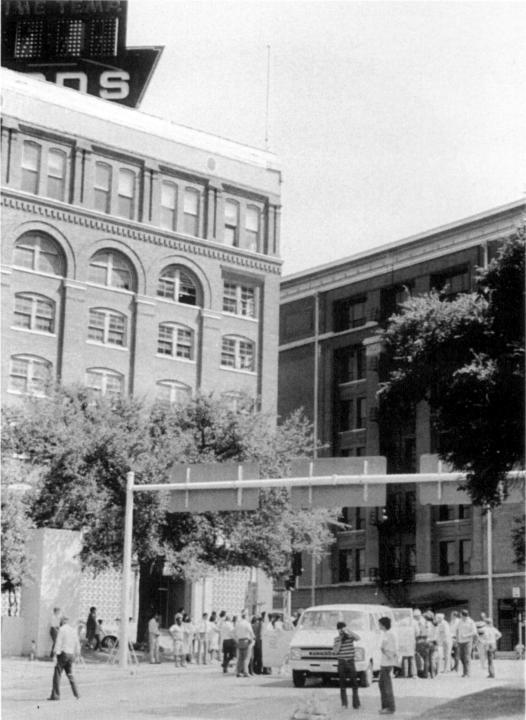
Copyright 1979 by TOM BLACKWELL
In 1979, the House Select Committee on Assassinations recreated the JFK
assassination gunshots at Dealey Plaza as part of acoustical studies which
ultimately led to the conclusion that more than one gunman fired on the
President. Notice at bottom right, the pile of sandbags has been placed near
the south curb of Elm Street. The sharpshooter firing from the sixth floor of
the Texas School Book Depository ordered the bags moved from the center
of the street, the location of the first shots into Kennedy's limousine,
because he could not get a line of sight through the intervening tree. The
same problem existed in 1963. Two years earlier, this tree had been trimmed
back to its 1963 configuration for the filming of a television docudrama on
the assassination.

This view from the infamous sixth-floor "sniper's nest" window of the Texas
School Book Depository shows several problems with the lone-assassin theory of
the assassination. The height of the window sill, about a foot off the floor along
with the half-opened window and the two pipes on the left, provide serious
obstacles to anyone trying to sight down Elm street. Furthermore, the tree on the
street below obscures a line of sight to the center of the street at about the position
of the overhead highway sign which marks the location of the first shot which
struck Kennedy. The author made this photo shortly after the tree was trimmed
back to its 1963 configuration for a television docudrama in 1977.